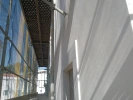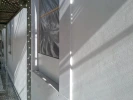Diasen Argatherm
Product Overview
Main purpose
To achieve an authentic beautiful finish while maintaining the breathability of the wall/ceiling.
Use it on
All Diasen Diathonite plasters, Watstop and any new or old lime or cement-based plasters.
Overview
Argatherm is a highly breathable smoothing and finishing plaster specially designed as a skim coat for Diasen Diathonite plasters. It is mould resistant and made from natural materials such as hydrated lime, expanded mineral fillers and pure limestone powder. It can be applied internally or externally by trowel or by spraying with a suitable machine. Argatherm should always be painted with a breathable paint to complete the installation.
Where to use it
Before you start your project, it is essential to investigate and fix any existing damp or moisture related issues in the wall; please see our installation guide for full details.
Argatherm is used internally or externally typically as a smoothing and finishing plaster over Diasen Diathonite thermal plasters. When applied over Diathonite, no other preparation of the surface is required. It is suitable for new builds and retrofit projects, including refurbishment of Heritage and Listed buildings.
Argatherm is also compatible with other lime or cement based plasters (new or old) and Diasen's Watstop Waterproofing System.
What it does
Diasen Argatherm covers the granular texture of Diathonite Evolution and Diathonite Thermactive to provide a breathable semi-smooth finish. Containing natural thermal aggregates, Argatherm also provides an additional thermal benefit to the wall.
It is easy to mix to a consistent texture and offers excellent workability. It can be hand applied or spray applied with a plaster spraying machine for quicker application in large areas.
Similar to other breathable finishing plasters, Argatherm is quite absorbent so needs to be painted with a natural breathable paint to remain clean and stain free.
How it works
Argatherm is easy to mix, just needing clean water adding to create a consistent mixture with excellent workability. It is lime-based and in combination with Diathonite thermal plasters, provides excellent thermal comfort and humidity balance while maintaining the breathability of the wall.
Why we love it
Argatherm can be used in place of Argacem HP providing the same semi-smooth surface finish over Diathonite plasters. Argatherm has a lower thermal conductivity compared to Argacem HP, so provides a small thermal improvement to your finished Diathonite plaster. The coverage of Argatherm is greater than Argacem HP, however the cost per m² is approximately the same.
An experienced lime plasterer or DIY enthusiast can install Argatherm with no special training. It can be finished with a sponge to achieve a traditional look or with a plastic float for a more contemporary aesthetic.
Containing only natural materials, Argatherm qualifies for LEED points; this makes it an ideal choice in projects with strict environmental requirements.
Argatherm is non-combustible and does not emit smoke. It can therefore contribute to improved fire safety of the building.
Features
- All-natural materials
- Easy to mix
- Grain size 0-0.6mm
- No special training required
- Fireproof and non-combustible
- Low thermal conductivity
- Breathable (vapour open)
- Durable finish
Benefits
- Completes a breathable wall on top of Diathonite plasters, regulating humidity & preventing mould growth.
- Smooths plaster surfaces to achieve a traditional or contemporary finish.
- Any experienced lime plasterer or DIY enthusiast can install.
- Does not burn or smoke to help improve fire safety.
- Easy to mix with excellent workability and consistency, and can be hand applied or sprayed with a plaster machine.
Questions
There are currently no questions and answers published for this product
Technical Details
Key Technical Data
Installation Guide
Find an installerBefore You Start
Before installing any internal wall insulation, it is essential to investigate and fix any existing damp or moisture related issues in the wall. Even though our internal wall systems are breathable and provide optimal protection against condensation, persistent damp issues must be resolved first. A wet wall is a cold wall, so preparation to remove or reduce external sources of moisture is key to achieving optimum results.
Once damp issues have been resolved, the wall should be allowed to dry thoroughly and re-assessed for suitability of internal wall insulation.
Any existing gypsum plaster on the internal side of the wall should be removed first to reveal the stone or masonry underneath. This ensures the wall will be fully breathable and allows the Diathonite to work to its full potential. It also provides a reliable key for maximum adhesion of the Diathonite to the wall.
These are the main considerations before commencing any work:
- Is there evidence of moisture in the walls?
- Is there any evidence of condensation, fungus or mould growth on the internal walls?
- Is there a functioning damp proof course (DPC)?
- Is there sufficient ventilation in the property?
- Is the external ground level higher than the floor level inside?
- Are there any structural defects in the external walls?
- Is guttering, flashings and external pipework in good condition?
- Is the external render, pointing or cladding in good condition and providing adequate weather protection?
- Is the external finish suitable for the severity of wind driven rain exposure?
- Are the timber joists embedded in external walls free from infestation and rot?
- Has the building ever been flooded?
- If you chose not to remove existing plaster on the wall, is this plaster fully compatible with the insulation system being used? (Ideally, it would need to be lime-based)
When applied over fully dried Diathonite plasters, Argatherm requires no special surface preparation. Over old plasters, an adhesion test is recommended to determine if Aquabond primer is required first.
In extremely hot weather, we recommend misting the surface with water before application, especially if the area is exposed to the sun. If primer has been used on the surface, misting will not be required.
Add approximately 6.5-7 litres of clean water per 25kg bag of Argatherm. This is equivalent to 26-28% water to plaster ratio. Mix with a drill mixer or automatic mixer until the product is smooth and all clumps are gone. Let the mixed plaster rest for 5 minutes, then mix it again and use immediately. Do not add any other material or substance to the mixture.
Argatherm should be applied in two layers with a steel plastering spatula. Each layer should be approximately 1.0-1.5mm thick. The first layer smooths over the texture of the Diathonite and regulates the porosity of the surface. When the first layer is firm to the touch after approximately 12-24 hours (at 20C, 40% relative humidity), the second layer can be applied. Spray the surface with water before applying the second layer of plaster.
If Argatherm is the final finish required with no Argacem Ultrafine being used, Diasen Polites-80 reinforcing mesh is recommended to be used at stress points around windows, corners and power sockets. The mesh should be applied between the first and second layers. Sections of mesh should overlap by 100mm.
Diasen Polites-80 reinforcing mesh must always be used over the entire area if Argacem Ultrafine finish will be applied over the top of Argatherm.
When the second coat is still moist, finish with a damp sponge (for a semi-smooth granular texture) or plastic trowel for a more smooth finish.
Hints & Tips
Do not apply when the ambient temperature or the substrate temperature is below +5°C or above +35°C.
During summer, apply the product during the cooler hours of the day, away from the sun.
Do not apply if rain or frost is expected imminently. Do not apply during heavy fog or with relative humidity higher than 70%.
If Argatherm is used as finishing coat for Diathonite plasters, apply it at least 15 days after the application of the last coat of Diathonite.
Do not apply on painted surfaces, substrates treated with waterproofing agents, gypsum, scagliola substrates, wood, metal or plastic elements.
Before applying Argatherm, it is advisable to cover thresholds, window frames and any element that you don't want to be covered with plaster.










